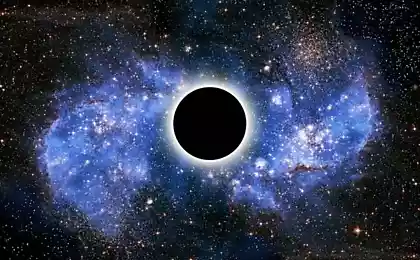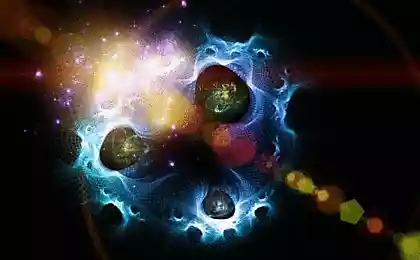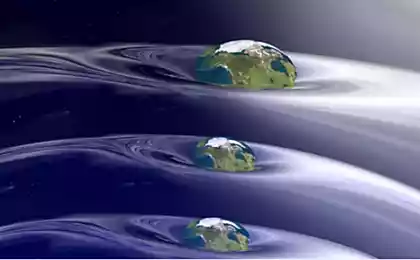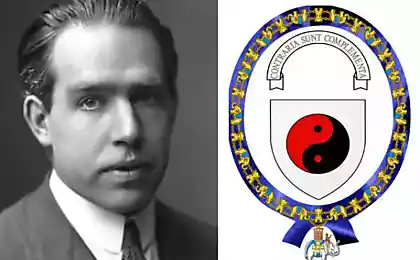1032
String theory: what does God think?
By Stephen Hawking accessible language
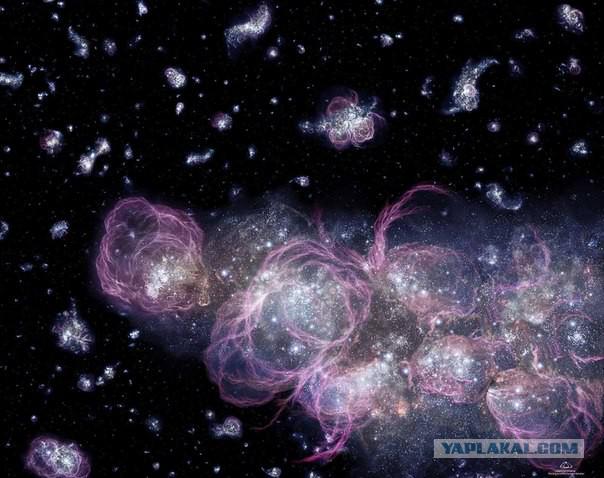
By the early 1980s. Physics literally drowned in a sea of elementary particles. Each time, breaking apart atom by a powerful particle accelerator, they, much to the amazement, found that of the splitting of the atom fly dozens of new particles.
This situation is so discouraging that Robert Oppenheimer said the Nobel Prize in Physics should be given to physics, which for the year will not open any new particles!
Enrico Fermi, horrified by how wildly multiply elementary particles with Greek letters in the names, said:
"If I was able to remember the names of all these particles, I'd be a botanist».
Only after decades of hard work this densely populated zoo managed to organize at least in some system called the Standard Model. Billions of dollars, hard work of thousands of engineers and physicists, and 20 Nobel Prizes allowed to lay down a mosaic of the Standard Model is literally in pieces.
Standard theoretical construct a model of particle physics, which describes the electromagnetic, weak and strong interaction of elementary particles. The Standard Model is not a theory of everything, because it does not describe dark matter, dark energy, and does not include gravity.
This is truly a remarkable theory which, as far as can be judged, all the experimental data of subatomic physics.
But the standard model, despite the success of the pilot, has one very serious drawback. As Stephen Hawking says, "she is ugly and rather arbitrary».
It at least 19 free parameters (including the mass of the particle and the strength of its interaction with other particles), 36 quarks and antiquarks, three important subatomic particles and their antiparticles, and many other subatomic particles with strange names such as gluons Yang Mills, Higgs bosons, W-bosons and Z-particles.
Worse, the Standard Model does not say anything about gravity. Hard to believe that nature at the primary, basic level can be as confusing and highly inelegant. This theory could love only the people who invested in her own soul. Lack of beauty in the Standard Model was enough to want to re-analyze the physics of his ideas about nature. Something was wrong.
If you look closely at the development of physics in the last few centuries, it turns out that one of the major achievements of the last of these was the reduction of all fundamental physical laws in the two great theories: quantum theory (represented by the Standard Model) and Einstein's general theory of relativity (which describes gravity). < br />
It is remarkable that these two theories together represent the full amount of physical knowledge at the fundamental level.
The first theory describes the world of the very small - subatomic quantum world where particles perform a fantastic dance, arise out of nothing and then disappear again and also manage to be in two places at once.
The second theory describes the world is very large; her interested in items such as black holes and the Big Bang; it uses the language of smooth surfaces, stretched canvas and distorted space.
These theories around opposite to each other, they use different mathematics, different axioms and different physical picture of the world. When you look at them, it seems that nature has two arms, completely unrelated to each other. Moreover, all attempts to combine both theory does not lead to any reasonable results. For half a century every physicist who tried at gunpoint to marry quantum theory and general relativity, quite unexpectedly found that any attempt to achieve his theory shatters into pieces and gives in response to infinity, devoid of any meaning.
All that changed with the arrival on the scene of string theory, which states that electrons and other subatomic particles are nothing but different vibrations of a string running around like a tiny rubber band.
If you pull the rubber band stretched, it will vibrate in different ways - with each note corresponds to a particular sub-atomic particle. Thus, superstring theory explains the existence of hundreds of subatomic particles discovered by scientists using accelerators. Moreover, Einstein's theory also fit into this theory as a manifestation of one of the low-frequency oscillations.
String theory even touted as the notorious "theory of everything", eluded Einstein the last 30 years of his life.
Einstein needed a single clear theory that would unite in itself all the laws of physics and allowed him "to know what God thinks." If string theory is right to unite gravity and quantum theory, it may be a great achievement of science in the last 2000 years - from the moment when the Greeks first asked the question: What is matter?
But string theory there is a very strange feature: most of these strings can fluctuate only in a certain space-time dimension - namely in ten. If we try to formulate a theory of strings to another dimension, nothing happens; mathematical apparatus simply fall apart.
Of course, our four-dimensional universe (in which three spatial dimensions and one time). This means that the remaining six measurements must be some way to collapse, or folded like a fifth dimension Kaluza.
In recent years, physicists began to think seriously about how to prove or, conversely, to deny the existence of these higher dimensions.
Perhaps the simplest way to ensure their existence - is to find deviations from Newton's law of universal gravitation. From school, we know that the force of Earth's gravity decreases with distance. More precisely, the force of attraction decreases with the square of the distance separating objects.
But this is true only because we live in a three-dimensional world. (Imagine a sphere around the Earth. The strength of the Earth's gravity is evenly distributed over the area of the sphere, so the more scope, the weaker the force of attraction. But the surface area of the sphere is proportional to the square of its radius, and therefore the force of attraction, distributed over the surface of the sphere, should decrease proportionally to the square radius.)
But if the universe had four spatial dimensions, the force of gravity would have to decrease in proportion to the cube of the distance. Generally, if the universe had n spatial dimensions, gravity it would be decreased in proportion to (n -1) th power of the distance.
The famous Newton's law that the force of attraction is inversely proportional to the square of the distance, checking on astronomical distances with high accuracy; that is why we can send space probes with amazing accuracy through the cracks in the rings of Saturn. But until recently, no one checked this law in the lab, at very small distances.
The first experiment was designed to test the law of inverse square of the distance the force of attraction, was held in 2003 at the University of Colorado. The experimental result was negative: apparently parallel universe does not exist, at least in Colorado not. But a negative result only whetted the appetites of other physicists who now hope to repeat this experiment with even greater precision.
Kip Thorne says:
"By 2020, physicists will have to understand the laws of quantum gravity, and it turns out that they are a variant of string theory».
Brian Greene, a theoretical physicist, Professor at Columbia University, one of the most renowned experts in the field of string theory.
In 1999 he published a book "The Elegant Universe. Superstrings, hidden dimensions and the Quest for the Ultimate Theory ". Is a prime promoter of science and organizer of the annual Festival of World Science Festival.
The main thesis of the scientist:
String theory was developed in order to answer the question of what made the matter. The molecule consists of atoms, atoms - of electrons, protons and neutrons, protons - from quarks. As Russian nesting dolls. However, all this means that where a particle is to be indivisible, the final point, which no longer has the structure. String theory suggests that perhaps it is not a particle. Inside the smallest point may be the energy structure, which vibrates as a string, but does not produce sound, and the particle. Depending on the frequency, the particles obtained are different.
The string is so small that if an atom were the size of the universe, it would be the size of a tree. That's why empirically string theory can not yet be confirmed. For three-dimensional space string theory does not fit. But if the measurement is greater than 10, it becomes consistent. Perhaps, these measurements are very small and can not be seen with the naked eye.
There are numbers that completely describe our universe. This fundamental physical constants: the masses of elementary particles, the coefficients of the electromagnetic interaction, and others. If you change any of these numbers, the world would simply cease to exist. Perhaps these constants depend on the form of additional measurements. Interaction measurement determines the interaction of the planets.
Observations have shown that the universe expands and accelerates, rather than slowing down. That spreads the galaxy? The fact that all of space is filled with fuel, dark energy which pushes them apart. And this is proved. How much dark energy needed to overcome gravity? Its volume numerically as follows: 128 zeros after the decimal point, and at the end of the number 138. Today it is the fundamental question of physics. Where did such a number? If more explosions were many, and each universe has its own amount of dark energy, it just means that our universe is that its volume.
Our universe will become more tenuous and uninhabitable. Life? -? it is generally very passing phenomenon. It can disappear into the void of space and time. But if there are other universes, then they have a life. Life here can be lost, but there again in another universe.
Universes may encounter, and this provokes oscillations. If we find them, it will be the most significant moment in history, which proves that we are not alone. But you can not go from one universe to another. We would get in the time of the Big Bang.
In Newton's physics there that you held in your hand. Today, we are far removed from this. Once we are able to face the fact that something is, in principle, can not understand. Maybe we're just not smart enough. Dog can learn a lot, but you will never be able to explain to her the theory of relativity. Although, maybe now some dog sitting and laughing at me.

By the early 1980s. Physics literally drowned in a sea of elementary particles. Each time, breaking apart atom by a powerful particle accelerator, they, much to the amazement, found that of the splitting of the atom fly dozens of new particles.
This situation is so discouraging that Robert Oppenheimer said the Nobel Prize in Physics should be given to physics, which for the year will not open any new particles!
Enrico Fermi, horrified by how wildly multiply elementary particles with Greek letters in the names, said:
"If I was able to remember the names of all these particles, I'd be a botanist».
Only after decades of hard work this densely populated zoo managed to organize at least in some system called the Standard Model. Billions of dollars, hard work of thousands of engineers and physicists, and 20 Nobel Prizes allowed to lay down a mosaic of the Standard Model is literally in pieces.
Standard theoretical construct a model of particle physics, which describes the electromagnetic, weak and strong interaction of elementary particles. The Standard Model is not a theory of everything, because it does not describe dark matter, dark energy, and does not include gravity.
This is truly a remarkable theory which, as far as can be judged, all the experimental data of subatomic physics.
But the standard model, despite the success of the pilot, has one very serious drawback. As Stephen Hawking says, "she is ugly and rather arbitrary».
It at least 19 free parameters (including the mass of the particle and the strength of its interaction with other particles), 36 quarks and antiquarks, three important subatomic particles and their antiparticles, and many other subatomic particles with strange names such as gluons Yang Mills, Higgs bosons, W-bosons and Z-particles.
Worse, the Standard Model does not say anything about gravity. Hard to believe that nature at the primary, basic level can be as confusing and highly inelegant. This theory could love only the people who invested in her own soul. Lack of beauty in the Standard Model was enough to want to re-analyze the physics of his ideas about nature. Something was wrong.
If you look closely at the development of physics in the last few centuries, it turns out that one of the major achievements of the last of these was the reduction of all fundamental physical laws in the two great theories: quantum theory (represented by the Standard Model) and Einstein's general theory of relativity (which describes gravity). < br />
It is remarkable that these two theories together represent the full amount of physical knowledge at the fundamental level.
The first theory describes the world of the very small - subatomic quantum world where particles perform a fantastic dance, arise out of nothing and then disappear again and also manage to be in two places at once.
The second theory describes the world is very large; her interested in items such as black holes and the Big Bang; it uses the language of smooth surfaces, stretched canvas and distorted space.
These theories around opposite to each other, they use different mathematics, different axioms and different physical picture of the world. When you look at them, it seems that nature has two arms, completely unrelated to each other. Moreover, all attempts to combine both theory does not lead to any reasonable results. For half a century every physicist who tried at gunpoint to marry quantum theory and general relativity, quite unexpectedly found that any attempt to achieve his theory shatters into pieces and gives in response to infinity, devoid of any meaning.
All that changed with the arrival on the scene of string theory, which states that electrons and other subatomic particles are nothing but different vibrations of a string running around like a tiny rubber band.
If you pull the rubber band stretched, it will vibrate in different ways - with each note corresponds to a particular sub-atomic particle. Thus, superstring theory explains the existence of hundreds of subatomic particles discovered by scientists using accelerators. Moreover, Einstein's theory also fit into this theory as a manifestation of one of the low-frequency oscillations.
String theory even touted as the notorious "theory of everything", eluded Einstein the last 30 years of his life.
Einstein needed a single clear theory that would unite in itself all the laws of physics and allowed him "to know what God thinks." If string theory is right to unite gravity and quantum theory, it may be a great achievement of science in the last 2000 years - from the moment when the Greeks first asked the question: What is matter?
But string theory there is a very strange feature: most of these strings can fluctuate only in a certain space-time dimension - namely in ten. If we try to formulate a theory of strings to another dimension, nothing happens; mathematical apparatus simply fall apart.
Of course, our four-dimensional universe (in which three spatial dimensions and one time). This means that the remaining six measurements must be some way to collapse, or folded like a fifth dimension Kaluza.
In recent years, physicists began to think seriously about how to prove or, conversely, to deny the existence of these higher dimensions.
Perhaps the simplest way to ensure their existence - is to find deviations from Newton's law of universal gravitation. From school, we know that the force of Earth's gravity decreases with distance. More precisely, the force of attraction decreases with the square of the distance separating objects.
But this is true only because we live in a three-dimensional world. (Imagine a sphere around the Earth. The strength of the Earth's gravity is evenly distributed over the area of the sphere, so the more scope, the weaker the force of attraction. But the surface area of the sphere is proportional to the square of its radius, and therefore the force of attraction, distributed over the surface of the sphere, should decrease proportionally to the square radius.)
But if the universe had four spatial dimensions, the force of gravity would have to decrease in proportion to the cube of the distance. Generally, if the universe had n spatial dimensions, gravity it would be decreased in proportion to (n -1) th power of the distance.
The famous Newton's law that the force of attraction is inversely proportional to the square of the distance, checking on astronomical distances with high accuracy; that is why we can send space probes with amazing accuracy through the cracks in the rings of Saturn. But until recently, no one checked this law in the lab, at very small distances.
The first experiment was designed to test the law of inverse square of the distance the force of attraction, was held in 2003 at the University of Colorado. The experimental result was negative: apparently parallel universe does not exist, at least in Colorado not. But a negative result only whetted the appetites of other physicists who now hope to repeat this experiment with even greater precision.
Kip Thorne says:
"By 2020, physicists will have to understand the laws of quantum gravity, and it turns out that they are a variant of string theory».
Brian Greene, a theoretical physicist, Professor at Columbia University, one of the most renowned experts in the field of string theory.
In 1999 he published a book "The Elegant Universe. Superstrings, hidden dimensions and the Quest for the Ultimate Theory ". Is a prime promoter of science and organizer of the annual Festival of World Science Festival.
The main thesis of the scientist:
String theory was developed in order to answer the question of what made the matter. The molecule consists of atoms, atoms - of electrons, protons and neutrons, protons - from quarks. As Russian nesting dolls. However, all this means that where a particle is to be indivisible, the final point, which no longer has the structure. String theory suggests that perhaps it is not a particle. Inside the smallest point may be the energy structure, which vibrates as a string, but does not produce sound, and the particle. Depending on the frequency, the particles obtained are different.
The string is so small that if an atom were the size of the universe, it would be the size of a tree. That's why empirically string theory can not yet be confirmed. For three-dimensional space string theory does not fit. But if the measurement is greater than 10, it becomes consistent. Perhaps, these measurements are very small and can not be seen with the naked eye.
There are numbers that completely describe our universe. This fundamental physical constants: the masses of elementary particles, the coefficients of the electromagnetic interaction, and others. If you change any of these numbers, the world would simply cease to exist. Perhaps these constants depend on the form of additional measurements. Interaction measurement determines the interaction of the planets.
Observations have shown that the universe expands and accelerates, rather than slowing down. That spreads the galaxy? The fact that all of space is filled with fuel, dark energy which pushes them apart. And this is proved. How much dark energy needed to overcome gravity? Its volume numerically as follows: 128 zeros after the decimal point, and at the end of the number 138. Today it is the fundamental question of physics. Where did such a number? If more explosions were many, and each universe has its own amount of dark energy, it just means that our universe is that its volume.
Our universe will become more tenuous and uninhabitable. Life? -? it is generally very passing phenomenon. It can disappear into the void of space and time. But if there are other universes, then they have a life. Life here can be lost, but there again in another universe.
Universes may encounter, and this provokes oscillations. If we find them, it will be the most significant moment in history, which proves that we are not alone. But you can not go from one universe to another. We would get in the time of the Big Bang.
In Newton's physics there that you held in your hand. Today, we are far removed from this. Once we are able to face the fact that something is, in principle, can not understand. Maybe we're just not smart enough. Dog can learn a lot, but you will never be able to explain to her the theory of relativity. Although, maybe now some dog sitting and laughing at me.










